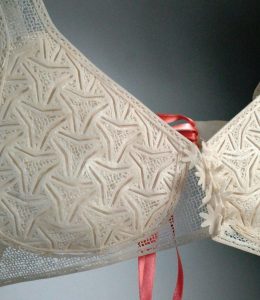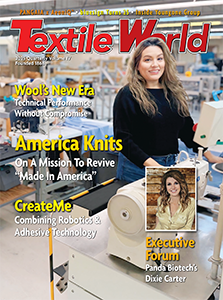 Designer Neyla Coronel utilized biobased Balena.Filaflex to create a 3D printed, custom bra that adapts to the body.
Designer Neyla Coronel utilized biobased Balena.Filaflex to create a 3D printed, custom bra that adapts to the body.
By Rachael S. Davis, Executive Editor
Thinking outside the box and beyond the sewing machine, designer Neyla Coronel set to create a custom-made bra that would be produced in a whole new way during her postgraduate studies at Fabricademy. The Textile and Technology academy offers six-month intensive programs at a variety of labs worldwide that explore the intersection of digital production, textiles and biology with a mission “to (re)shape and (re)define the implications and applications of technology in the textile and clothing industry, from the fashion sector to the upcoming wearable market.”
And reshape Coronel did. Her concept was to make a garment that adapted to the woman instead of a woman having to make do with the limited offerings in the marketplace. She combined parametric modeling, 3D scanning and auxetic geometries with 3D printing techniques to create a fully compostable, biobased bra. The bra’s design is adapted to body dimensions, movement and change over time; and the auxetic pattern was engineered to expand and contract in sync with the wearer.
Once the design was conceived, Coronel had to find the right material to use and eventually settled on Balena.Filaflex, a compostable, 3D printing filament that Israel-based material science company Balena co-developed with Spain-based Recreus. Balena focuses on biobased materials for extrusion, injection molding and 3D printing that can replace non-compostable plastics used in many industries. Recreus, the creator of Filaflex filaments for 3D printing, focuses on flexible materials to reimagine what is possible with additive manufacturing technology. Together, Balena and Recreus took Balena’s BioCir®flex3D material and created the biobased, fully circular and recyclable Balena.Filaflex 3D printing filament.
The softness and elasticity of the material offered many possibilities. “Working with Balena.Filaflex was a breakthrough,” Coronel said. “Its flexibility is essential for something worn so close to the body. But beyond that, it’s biobased, compostable and recyclable. It made the piece not just wearable, but meaningful.
“It invites designers to rethink what is possible,” Coronel stressed. “It expands what 3D printing can do in fashion — especially in pieces that need to move and respond to the human body.”
 “We’re proud to support projects like Neyla’s — it’s designers like her who show what’s possible when material innovation meets personal vision,” Balena said.
“We’re proud to support projects like Neyla’s — it’s designers like her who show what’s possible when material innovation meets personal vision,” Balena said.
This experience has motivated Coronel to look at other applications for Balena.Filaflex. including other intimate wear, footwear and even furniture. “Each new material brings a new learning curve,” she said.
“But Balena.Filaflex showed me how material science can support designs that are truly human and sustainable.”
Perhaps not broadly market-ready yet, at the very least, the bra represents a unique and interesting idea. It illustrates what’s currently possible and perhaps provides some insight to the future of garment making. According to Balena, the intimate garment “demonstrates how [Balena.Filaflex] material can bridge performance and purpose: offering comfort, adaptability and a radically reduced environmental footprint.”
For more information, visit the balena.science and recreus.com websites.
2025 Quarterly Issue II




